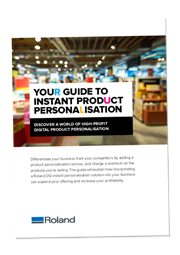Buyer Behaviour in the Current Retail Environment
Despite the impact of the online retail sector on brick and mortar retail, customers are returning to physical retailers as they seek the social immersive experiences this provides.
This is supported by a shift in spending on experiences rather than possessions, with customers increasingly dictating what they want, where they want it and when. They are looking for quality over quantity and are willing to spend more per purchase, especially if they can connect with the purchase on some level.
As a result, there is huge potential for businesses to incorporate a personalisation solution to connect with customers and stand out from the competition.
What is Personalisation?
Personalisation is the tailoring of a service or product to a specific individual, or segment of individuals. Businesses use personalisation to improve customer satisfaction, sales conversion, marketing results, branding, advertising, etc. Personalisation is now the norm for websites and digital marketing in order to track the interests and actions of a customer and tailor content based on this.
Product personalisation is now in high demand and can attract a premium price.
Variations of product personalisation include:
- Mass personalisation – products are mass-produced but are personalised to individual preferences. E.g. soft drinks or keyrings with individual names.
- Mass customisation – products are mass-produced with limited options to customise the product. E.g. football jerseys with selectable fonts, characters and numbers.
- Bespoke goods and services – the customer is involved in the process to create a unique product. E.g. photography shops and department stores where a customer’s image, logo, graphic can be printed or transferred onto items such as mugs, cushions, canvas frames, etc.
Technologies and Applications for Product Personalisation
A number of technologies and applications are available that can be used to create personalised products:
Print and cut – integrated print and cut machines offer versatility, durability and quality. The equipment you need to add wide format and custom short-run graphics is inexpensive to acquire and cost-efficient to operate, giving you a fast and impressive return on investment. Use print and cut machines for custom window and wall graphics, and unique contour cut labels and decals.

Heat transfer – print and contour cut full colour heat transfers for short run apparel, to create custom garments such as shirts, jackets, hats, and sportswear.
Dye sublimation – digital printing technology that allows you to heat transfer colourful images on textiles, wood, metal and other unique, high-value substrates. Personalise a range of materials including promotional items, giftware, home décor and textiles such as curtains, blinds, cushions, etc.

Engraving and marking – use an engraver or impact printer to add inscriptions, logos, graphics and images to a wide variety of surfaces such as awards, trophies, souvenirs, plaques, charms, pendants.

UV printing – small benchtop UV printers extremely cost effective and have a reasonably small footprint. They allow for printing to non-traditional surfaces such as acrylic, wood, metals, glass so you can transform ordinary, low cost objects into personalised, high-profit items. Economical for one-off and short runs, UV printing is fast replacing traditional methods such as screen and pad printing. UV printing technology is becoming more affordable and accessible so you can realise a return on investment sooner.

Guide to Instant Product Personalisation
To find out more about the growing product personalisation trend, and ways that you can expand your product offering to meet increasing customer demands, look at our FREE Guide to Instant Product Personalisation, available to download from our website.

